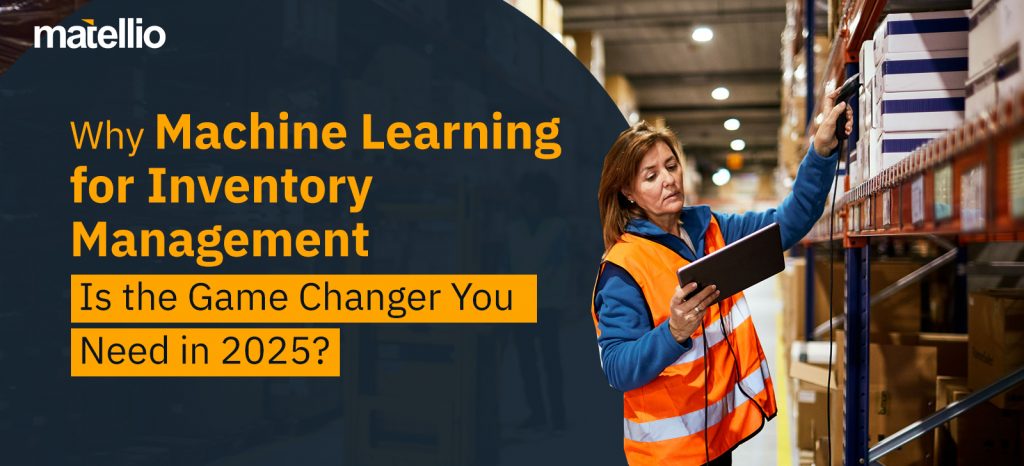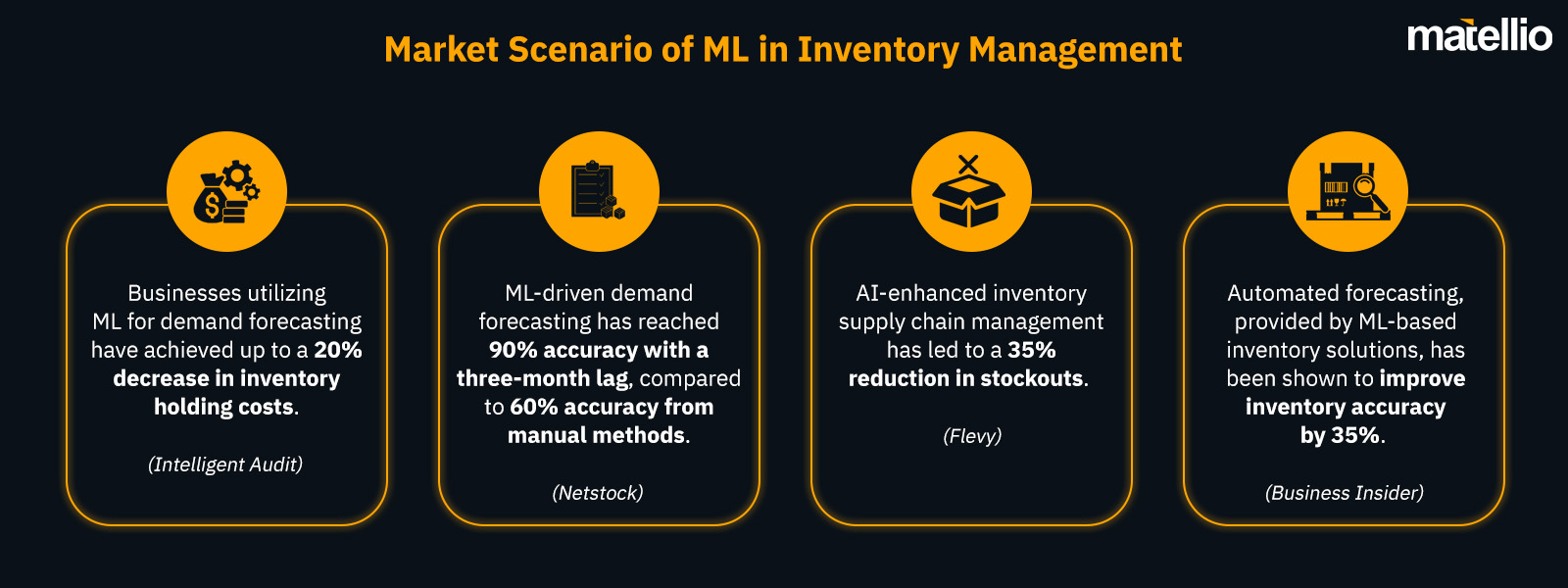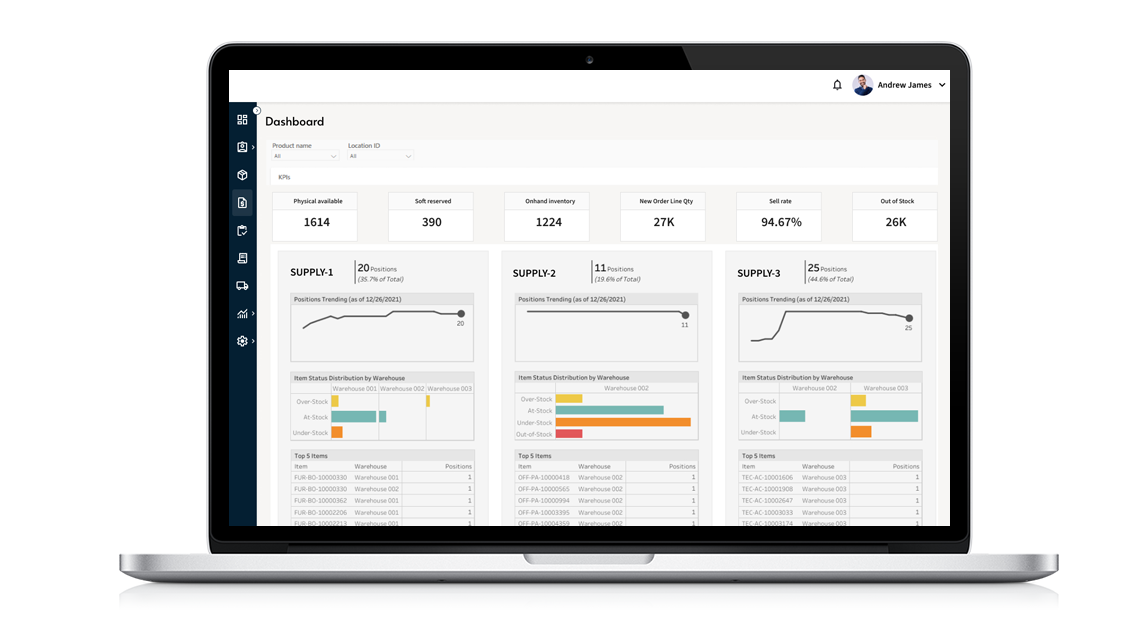
Did you know that the global automated inventory management market is projected to reach $20.98 billion by 2028? Not just that, machine learning for inventory management has enabled demand forecasting to achieve 90% accuracy, compared to just 60% with manual methods. That’s the power of machine learning inventory management at work!
Let’s face it—traditional inventory management methods are no longer sufficient in today’s fast-paced business environment. Challenges like monetary loss from excess stock, frustrated customers due to stockouts, constant guesswork in predicting demand, and hours wasted fixing human errors are draining your profits and cutting into your revenue.
But with inventory management using machine learning, you can put an end to these business headaches once and for all.
Imagine an intelligent system that learns from your data and helps you streamline your inventory and warehouse operations, reduce costs, and boost efficiency. A custom solution tailored to your unique business needs and industry trends, one that never guesses wrong, predicts demand with laser precision, and ensures your shelves are stocked with exactly what your customers want.
That’s not a pipe dream—that’s the power of machine learning inventory management in action. And here’s the best part—you can develop one such system for your business!
In this blog, we’ll uncover the top seven benefits of using machine learning for inventory management, explore the current market scenario, showcase real-world use cases, and guide you through the steps to develop a cutting-edge solution with next-gen features and technologies.
Why Traditional Inventory Management is Costing You More Than You Think
Let’s get to the heart of the matter. If you’re still relying on spreadsheets or outdated software to manage your inventory, you’re not just working harder—you’re losing money, time, and opportunities. Here’s how:
Stockouts and Overstocking
Stockouts and overstocking are the twin nightmares of inventory management. Each stockout can cost your business an average of 9% in lost sales annually. Meanwhile, overstocking ties up capital, increases storage costs, and creates waste. By adopting machine learning for inventory management, you can achieve precise stock levels, eliminating these costly inefficiencies.
Human Errors and Guesswork
Manual processes are inherently prone to errors. A single miscalculated demand forecast, or an overlooked stock re-order can cascade into lost sales or excess inventory. With inventory management using machine learning, these errors are a thing of the past. ML systems rely on data, not guesswork, ensuring accurate predictions and streamlined operations.
No Room for Scalability
As your business grows, inventory management becomes exponentially more complex. Traditional tools lack the adaptability to scale efficiently or respond to market fluctuations. That’s why businesses are turning to machine learning inventory management solutions to handle growing SKUs, multiple locations, and evolving market demands. Machine learning for inventory optimization ensures your operations stay agile, no matter how large or complex your business becomes.
To overcome such issues, machine learning for inventory management comes into play!
Modern businesses aren’t just overcoming these challenges; they’re thriving by adopting machine learning for inventory management. These advanced systems are rewriting the rules of inventory management. Well, that’s what the stats reveal:

But these are not the only reasons why machine learning for inventory management is essential. Here’s what you can enjoy with this trend for your company:
 Predictive Intelligence: Staying Ahead of the Curve
Predictive Intelligence: Staying Ahead of the Curve
Machine learning for inventory management doesn’t wait for problems to occur—it predicts them before they happen. By analyzing historical data, market trends, and consumer behavior, machine learning in demand forecasting delivers highly accurate predictions. This ensures you’re always prepared, no matter how volatile or unpredictable the market becomes, allowing you to stay one step ahead of your competition.
 Automated Decision-Making: Simplify and Optimize
Automated Decision-Making: Simplify and Optimize
Forget manual reordering and the headaches of managing complex spreadsheets. Machine learning for inventory optimization automates critical decisions, such as restocking at precise levels and identifying slow-moving inventory. This approach reduces human errors and frees up your team to focus on more strategic growth initiatives. By leveraging machine learning consulting services, businesses can build custom solutions that align perfectly with their operational goals.
 End-to-End Visibility: Gain Full Control
End-to-End Visibility: Gain Full Control
Modern inventory management systems powered by machine learning for inventory optimization provide a unified, real-time view of your supply chain. From monitoring stock levels across multiple locations to identifying and addressing bottlenecks, ML-based systems give you total control over your operations, ensuring efficiency and clarity at every stage.
 Real-Time Adaptability: Agile and Resilient Operations
Real-Time Adaptability: Agile and Resilient Operations
Unlike traditional systems that are rigid and static, machine learning for inventory management adapts dynamically to changes in demand, seasonal trends, and supply chain disruptions. This agility allows your business to respond quickly to market shifts and capitalize on emerging opportunities, ensuring you remain competitive even in challenging conditions.
 Beyond Inventory: Unlock Strategic Growth
Beyond Inventory: Unlock Strategic Growth
Machine learning in demand forecasting doesn’t just manage inventory—it drives business transformation. By reducing costs, maintaining optimal stock levels, and improving customer satisfaction, you unlock new opportunities for revenue growth and scalability. Implementing machine learning for inventory optimization ensures your business is equipped for the future, creating long-term resilience and success. Leverage AI development services to start reaping the benefits today!
All in all, every day you stick with traditional methods is a day you fall behind competitors who’ve embraced modern, data-driven solutions. Machine learning inventory management isn’t just about solving yesterday’s problems—it’s about preparing your business for tomorrow’s opportunities.
Are you ready to leave inefficiency behind and join the leaders driving innovation in inventory management? The choice is clear—the time to upgrade is now.
Also Read: Discover how the Future of Inventory Management is evolving with custom solutions, enabling businesses to optimize operations, reduce costs, and enhance supply chain efficiency.
Let’s Solve Your Inventory Management Challenges with ML Services! Get Started with a Free 30-minute Consultation!
7 Ways You Can Use Machine Learning for Inventory Management
Let’s cut to the chase. You’re working tirelessly to manage reorder points, maintain safety stock, perform cycle counts, and track SKUs (stock keeping units) across multiple locations. But here’s the truth: your traditional methods are holding you back. They’re slowing you down, creating errors, and costing your business money. It’s time to embrace machine learning inventory management—a cutting-edge system that understands your pain points, solves them, and transforms your operations.
Flawless Reorder Point Management
Manually calculating reorder points is outdated and error-prone. Forget spreadsheets. With machine learning inventory management, algorithms dynamically calculate reorder points based on real-time data, lead times, and historical sales trends. This ensures every SKU gets replenished precisely when needed, minimizing costly backorders and eliminating excess inventory. Businesses adopting inventory management using machine learning experience unparalleled efficiency and cost savings.
Precision Safety Stock Calculations
Managing safety stock is a balancing act. Too little leads to stockouts; too much locks up your capital. ML-based inventory management software analyzes demand variability, supplier reliability, and lead times to calculate optimal safety stock levels for each SKU. With machine learning for retail stores, you’re always prepared for unexpected demand spikes without draining your resources.
Automated ABC Analysis for Inventory Prioritization
Not all inventory is created equal. With inventory management software development using machine learning, you can automate ABC analysis to classify SKUs into high-priority (A), medium-priority (B), and low-priority (C) categories. ML-powered systems evaluate factors like sales velocity, profitability, and demand frequency, enabling you to focus on the products that drive the most revenue. Automating this process not only increases efficiency but frees up time to focus on strategic growth.
Advanced Demand Forecasting for Peak Accuracy
Seasonality, market trends, and external factors can disrupt your forecasting. Enter machine learning in demand forecasting, which analyzes both historical data and real-time external factors like holidays or weather. The result? Predictions that are actionable, reliable, and adaptable—giving you the confidence to plan inventory, production, and logistics with unmatched precision.
Real-Time SKU-Level Tracking
Tracking thousands of SKUs across multiple locations manually is inefficient and error-prone. ML-based inventory management software provides centralized, real-time visibility, whether it’s monitoring inbound shipments, tracking fast-moving SKUs, or identifying bottlenecks. With this technology, paired with cloud integration services, you’ll always know exactly where your inventory stands, making informed decisions quickly and effectively.
Proactive Dead Stock Mitigation
Dead stock drains resources, ties up valuable storage, and impacts profitability. Machine learning inventory management software analyzes historical sales, product life cycles, and current trends to identify items at risk of becoming dead stock. Act early by discounting, bundling, or liquidating these items, transforming liabilities into opportunities and ensuring your inventory stays lean and profitable.
Intelligent Cycle Counting for Unmatched Accuracy
Inaccurate stock counts can disrupt operations and lead to costly mistakes. Inventory management using machine learning automates cycle counting, prioritizing high-risk SKUs and identifying patterns in discrepancies. This ensures your inventory ledger remains accurate and up-to-date, minimizing disruptions while saving time and reducing operational costs.
Why You Can’t Wait Any Longer
Traditional inventory management isn’t just inefficient—it’s actively costing you money. By adopting machine learning for inventory management, you’re not just fixing what’s broken; you’re setting a new standard for how inventory should be managed.
With machine learning as a service, you can:
- Reduce carrying costs by optimizing stock turnover.
- Automate complex tasks like reorder points and ABC analysis.
- Achieve unprecedented accuracy in demand forecasting and cycle counting.
- Enhance visibility across all warehouses and locations.
Your competitors are already leveraging machine learning for inventory management to revolutionize their operations. The question is: why aren’t you?
Let’s get started. Submit RFP today to see how machine learning can transform your inventory management. The time to act is now!
Real-World Success: How We Helped a Client Transform Their Inventory Management and Thrive
Nothing speaks louder than results. Let us share a real-world example of how we helped a client overcome the challenges of traditional inventory management and emerge stronger, more efficient, and future ready.
The Challenge: Outdated Tools Hindering Growth
One of our clients, a global leader in eCommerce fulfillment and consulting, faced critical issues due to their reliance on legacy inventory management systems. Their challenges included:
- High Costs: Expensive subscription-based licensing drained their resources without delivering sufficient value.
- Inefficiency: Slow query responses and redundant dashboards made data access and decision-making frustratingly slow.
- Manual Processes: Inventory management and order handling relied heavily on outdated, manual workflows that created bottlenecks.
- Scalability Issues: The system could not handle growing order volumes, restricting their ability to meet increasing demand in the fast-paced eCommerce sector.
These limitations not only caused operational inefficiencies but also jeopardized their competitiveness in a market where agility is everything.
The Solution: A Future-Ready Platform Tailored to Their Needs
When this client partnered with Matellio, we knew they needed more than just an upgrade—they needed a complete transformation.
Here’s how we tackled their problems using cutting-edge technology: 
- Scalable Architecture: We replaced their monolithic system with a modular, scalable architecture capable of handling large order volumes and adapting to future growth.
- Automation of Workflows: Manual inventory and order processes were automated, dramatically reducing human errors and freeing up resources for strategic initiatives.
- Advanced Data Architecture: Our solution provided lightning-fast query response times and real-time actionable analytics, enabling data-driven decisions.
- Third-Party Integration: Seamless integration with platforms like Amazon and Shopify ensured smooth inventory, order, and shipment management.
- Cost-Efficiency: We eliminated recurring subscription costs with a one-time capital investment in their custom solution, delivering long-term value.
The Results: A Game-Changing Transformation
The impact was immediate and measurable. Here’s what the client achieved after implementing machine learning for inventory management and automation solutions with Matellio:
- Streamlined Operations: Automated workflows significantly reduced inefficiencies and operational overheads.
- Cost Savings: Subscription costs were replaced with a one-time investment, leading to sustained financial benefits.
- Enhanced User Experience: The new platform delivered a smoother and more intuitive experience across workflows.
- Future-Ready Scalability: The system now supports growing order volumes, ensuring the client remains competitive as they scale.
- Actionable Insights: Strengthened reporting and analytics provided unparalleled visibility into inventory and operational performance.
Why This Matters to You
This transformation is not just a success story—it’s proof that businesses like yours can achieve incredible results with the right solutions. Whether you’re struggling with outdated systems, high operational costs, or inefficiencies in inventory management challenges, machine learning for inventory optimization can be the catalyst that drives your growth.
Here’s the takeaway: You don’t have to settle for inefficiencies. Like our client, you too can unlock:
- Reduced costs and better ROI.
- Automation that frees up valuable time and resources.
- Seamless operations that adapt as you grow.
Your competitors are already exploring these solutions—why not you? Let us help you transform your operations and achieve scalable success.
Also Read: Explore how Custom Retail Operations Software can streamline your business by unifying processes with AI-driven decision-making and advanced analytics for smarter operations and enhanced efficiency.
Want a Similar Transformation for Your Company? Contact Our Experts and Leverage Our Business-focused Services Today!
How to Implement Machine Learning in Inventory Management in 6 Easy Steps
So, you’re ready to revolutionize your inventory operations with machine learning for inventory management—but where do you start? Implementing machine learning isn’t just about adopting technology; it’s about understanding your needs, choosing the right partners, and building a solution that works seamlessly for your business. Here’s a step-by-step guide to help you navigate the process.
 Define Your Goals and Identify Key Problems
Define Your Goals and Identify Key Problems
Begin by asking yourself:
- What problems are you trying to solve? Are stockouts, overstocking, or inefficient cycle counts draining your resources?
- Do you need to optimize inventory levels, improve machine learning in demand forecasting, or reduce operational costs?
Clearly defining your objectives is the first step toward building a solution that addresses your unique business challenges. Knowing your pain points ensures you focus your resources on the areas that deliver the highest impact with inventory management using machine learning.
 Gather and Organize Your Data
Gather and Organize Your Data
Machine learning inventory management thrives on high-quality, structured data. Start by collecting:
- Historical Sales Data: Trends and seasonality for at least 12 months.
- Inventory Records: SKU-specific data, stock levels, reorder points, and turnover rates.
- Supplier Data: Lead times, reliability, and associated costs.
- Demand Influencers: Promotional calendars, market trends, and customer behavior data.
Clean, consistent, and complete data is the foundation of an accurate and effective ML-based inventory management software. Without it, even the most advanced algorithms won’t deliver the results you need. Consider data consulting services if you need help organizing your datasets.
 Choose a Trusted Enterprise Software Development Partner
Choose a Trusted Enterprise Software Development Partner
Implementing machine learning for inventory optimization isn’t a DIY project. You need a skilled partner having expertise in enterprise software development services to guide you through every stage of development, from strategy to deployment. Here’s what to look for in a partner:
- Proven Expertise: Look for a company with a track record of successful inventory management software development projects. They should understand inventory-specific challenges like safety stock optimization, cycle counting, and demand forecasting.
- Scalability and Flexibility: Ensure the partner can build a system that scales as your business grows, whether by adding SKUs, expanding locations, or integrating with retail software development services or platforms like Shopify and Amazon.
- Tailored Solutions: Avoid one-size-fits-all systems. A trusted partner will offer custom development, leveraging machine learning consulting services to create a solution tailored to your unique operations.
- Comprehensive Integration: They should ensure seamless integration with your existing systems, such as ERPs, WMS platforms, and supply chain tools, to create a unified, data-driven ecosystem.
Choosing the right partner ensures your ML-based inventory management software is efficient, effective, and ROI-driven.
 Start with an MVP (Minimum Viable Product)
Start with an MVP (Minimum Viable Product)
Rather than diving into a full-scale implementation, start small with an MVP. Focus on a specific area, such as:
- Demand Forecasting: Use machine learning in demand forecasting to predict stock needs with high accuracy.
- Reorder Point Automation: Automate restocking for high-priority SKUs to test how ML-driven decision-making improves efficiency.
MVP development services allow you to gather feedback, identify improvement areas, and refine your machine learning inventory management system before rolling it out across your entire operation.
 Embrace Agile Development and Rigorous Testing
Embrace Agile Development and Rigorous Testing
Machine learning evolves over time, so agile development is essential. Build your system in iterative phases and incorporate feedback from real-world scenarios. Focus on:
- Accuracy Testing: Does the system effectively predict demand and optimize reorder points?
- Efficiency Gains: Are you reducing carrying costs, stockouts, and overstocking with your inventory management using machine learning?
- Integration Usability: Ensure seamless compatibility with tools like ERPs or retail software development services.
Testing with historical and live data ensures your system performs reliably once deployed.
 Plan for Scalability and Long-Term Growth
Plan for Scalability and Long-Term Growth
The true power of machine learning for inventory management lies in its ability to grow with your business. Your solution should:
- Adapt to new SKUs, warehouses, and geographic regions.
- Integrate with digital transformation services to incorporate IoT, automation, and advanced analytics.
- Provide long-term insights for strategic decisions, such as optimal inventory placement and supply chain efficiency.
Planning ahead ensures your system remains scalable, flexible, and future-ready, giving your business a competitive edge.
In short, implementing inventory management using machine learning doesn’t have to be overwhelming. By following these six steps, you’ll not only simplify the process but also unlock transformative business benefits. The only key here is to hire ML developers from a trusted partner.
Also Read: Discover how AI-Powered Product Development is transforming retail innovation with personalized strategies and enhanced customer experiences.
That’s Exactly Where Matellio Comes In!
When it comes to machine learning for inventory management, choosing the right partner can make all the difference between a system that simply functions and one that transforms your business.
At Matellio, we don’t just implement technology—we deliver solutions that elevate your operations, cut costs, and future-proof your business. Here’s why we are the trusted choice for inventory managers, warehouse operators, and business owners worldwide.
 Expertise in Advanced Machine Learning and AI
Expertise in Advanced Machine Learning and AI
Our team of experts excels in delivering cutting-edge machine learning for inventory optimization. From implementing predictive analytics to designing complex algorithms for machine learning in demand forecasting, we leverage the latest advancements to give you a competitive edge. With Matellio, you don’t just get software—you get a state-of-the-art software product development services that learn and improve over time.
Read More: Discover how AI inventory management software is transforming inventory operations by automating stock tracking, reducing waste, and optimizing supply chains for maximum profitability.
 Tailored Solutions for Your Unique Business Needs
Tailored Solutions for Your Unique Business Needs
At Matellio, we understand that no two businesses are alike. That’s why our approach to inventory management software development focuses on creating customized solutions tailored to your industry, size, and operational challenges. Whether you need machine learning for demand forecasting, automated reorder point management, or seamless multi-location tracking, we implement machine learning inventory management software that fits your needs perfectly.
 Seamless Integration with Existing Systems
Seamless Integration with Existing Systems
Unlike one-size-fits-all solutions, our systems are designed for compatibility. Whether you’re using ERPs, retail software development services, or third-party platforms like Amazon and Shopify, we ensure seamless integration for a unified experience. Our system integration services also help you connect disparate tools into a cohesive ecosystem, improving visibility and efficiency across your supply chain.
 Proven ROI with Cost-Effective Solutions
Proven ROI with Cost-Effective Solutions
At Matellio, we deliver results without breaking the bank. Our solutions eliminate recurring subscription costs by replacing them with a one-time capital investment, offering a significant long-term ROI. By automating labor-intensive processes and reducing inefficiencies, our clients experience measurable savings in carrying costs, dead stock reduction, and improved stock turnover rates.
 Scalable Architecture for Long-Term Growth
Scalable Architecture for Long-Term Growth
We build systems that grow with your business. Whether you’re adding new SKUs, expanding warehouses, or entering new markets, our solutions are built on scalable architectures to support your journey. With our expertise in digital transformation services, your AI-based inventory management system is future-ready, capable of adapting to evolving business needs without costly overhauls.
 End-to-End Support and Agile Delivery
End-to-End Support and Agile Delivery
From consultation to deployment and beyond, we provide comprehensive support at every stage of your project. Our agile development approach ensures flexibility, while our rigorous testing processes guarantee a smooth and successful implementation. With our commitment to quality, we ensure your machine learning inventory management system delivers value from day one.
Let’s build the future of your business with machine learning services and solutions. Begin your transformation journey by scheduling a free 30-minute call with our experts!
Machine Learning for Inventory Management – FAQ:
Q1. How long does it take to implement machine learning inventory management?
The timeline depends on the complexity of your operations but typically ranges from 3-6 months, including testing and integration.
Q2. Can machine learning work with my existing inventory system?
Yes, machine learning solutions can integrate with most existing ERP or WMS platforms for seamless functionality and data sharing.
Q3. Is machine learning only for large-scale businesses?
No, machine learning can be tailored for businesses of all sizes, offering scalable solutions that grow alongside your operations.
Q4. Do I need technical expertise to manage a machine learning system?
Not necessarily. A well-designed system will have user-friendly dashboards and automated workflows, requiring minimal technical know-how.
Q5. What’s the ROI of implementing machine learning for inventory management?
Clients typically see significant cost reductions, improved forecasting accuracy, and increased efficiency within months of implementation.
 Predictive Intelligence: Staying Ahead of the Curve
Predictive Intelligence: Staying Ahead of the Curve Automated Decision-Making: Simplify and Optimize
Automated Decision-Making: Simplify and Optimize End-to-End Visibility: Gain Full Control
End-to-End Visibility: Gain Full Control Real-Time Adaptability: Agile and Resilient Operations
Real-Time Adaptability: Agile and Resilient Operations Beyond Inventory: Unlock Strategic Growth
Beyond Inventory: Unlock Strategic Growth Define Your Goals and Identify Key Problems
Define Your Goals and Identify Key Problems Gather and Organize Your Data
Gather and Organize Your Data Choose a Trusted Enterprise Software Development Partner
Choose a Trusted Enterprise Software Development Partner Start with an MVP (Minimum Viable Product)
Start with an MVP (Minimum Viable Product) Embrace Agile Development and Rigorous Testing
Embrace Agile Development and Rigorous Testing Plan for Scalability and Long-Term Growth
Plan for Scalability and Long-Term Growth Expertise in Advanced Machine Learning and AI
Expertise in Advanced Machine Learning and AI Tailored Solutions for Your Unique Business Needs
Tailored Solutions for Your Unique Business Needs Seamless Integration with Existing Systems
Seamless Integration with Existing Systems Proven ROI with Cost-Effective Solutions
Proven ROI with Cost-Effective Solutions Scalable Architecture for Long-Term Growth
Scalable Architecture for Long-Term Growth End-to-End Support and Agile Delivery
End-to-End Support and Agile Delivery

